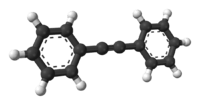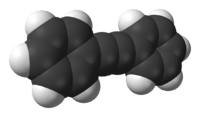Diphenylacetylene
Diphenylacetylene is the chemical compound C6H5C≡CC6H5. The molecule consists of phenyl groups attached to both ends of an alkyne. It is a colorless crystalline material that is widely used as a building block in organic synthesis and as a ligand in organometallic chemistry.
 | |
 | |
 | |
| Names | |
|---|---|
| Preferred IUPAC name
1,1'-(Ethyne-1,2-diyl)dibenzene | |
| Other names
1,2-Diphenylethyne 2-Phenylethynylbenzene Tolan Diphenylacetylene | |
| Identifiers | |
3D model (JSmol) |
|
| 606478 | |
| ChEBI | |
| ChEMBL | |
| ChemSpider | |
| ECHA InfoCard | 100.007.206 |
| EC Number |
|
PubChem CID |
|
| UNII | |
CompTox Dashboard (EPA) |
|
| |
| |
| Properties | |
| C14H10 | |
| Molar mass | 178.234 g·mol−1 |
| Appearance | Colorless solid |
| Density | 0.990 g cm−3 |
| Melting point | 62.5 °C (144.5 °F; 335.6 K) |
| Boiling point | 170 °C (338 °F; 443 K) at 19 mmHg |
| Insoluble | |
| Structure | |
| 0 D | |
| Hazards | |
| Safety data sheet | Oxford MSDS |
| Related compounds | |
Related compounds |
2-Butyne Dimethyl acetylenedicarboxylate |
Except where otherwise noted, data are given for materials in their standard state (at 25 °C [77 °F], 100 kPa). | |
| Infobox references | |
Preparation
In one preparation for this compound, benzil is condensed with hydrazine to give the bis(hydrazone), which is oxidized with mercury oxide.[1] Alternatively stilbene is brominated, and the resulting dibromodiphenylethane is subjected to dehydrohalogenation,[2] Yet another method starts involves the coupling iodobenzene and the copper salt of phenylacetylene in the Castro-Stephens coupling.
Derivatives
Reaction of Ph2C2 with tetraphenylcyclopentadienone results in the formation of hexaphenylbenzene.[3] Reaction of Ph2C2 with benzal chloride in the presence of potassium t-butoxide affords the 3-alkoxycyclopropene which coverts to the cyclopropenium ion.[4]
References
- Cope, A. C.; Smith, D. S.; Cotter, R. J. "Diphenylacetylene". Organic Syntheses.; Collective Volume, 4, p. 377
- Lee Irvin Smith and M. M. Falkof. "Diphenylacetylene". Organic Syntheses.; Collective Volume, 3, p. 350
- Fieser, L. F. "Hexaphenylbenzene". Organic Syntheses.; Collective Volume, 5, p. 604
- Xu, Ruo; Breslow, Ronald (1997). "1,2,3-Triphenylcyclopropendium Bromide". Organic Syntheses. 74: 72. doi:10.15227/orgsyn.074.0072.; Collective Volume, 9, p. 730